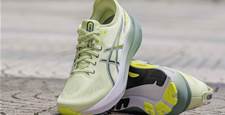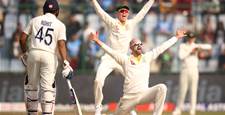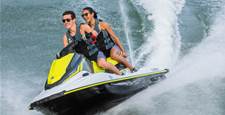The Port Macquarie (NSW) school teacher loves pedalling – the longer, the better.
The Port Macquarie (NSW) school teacher loves pedalling – the longer, the better.
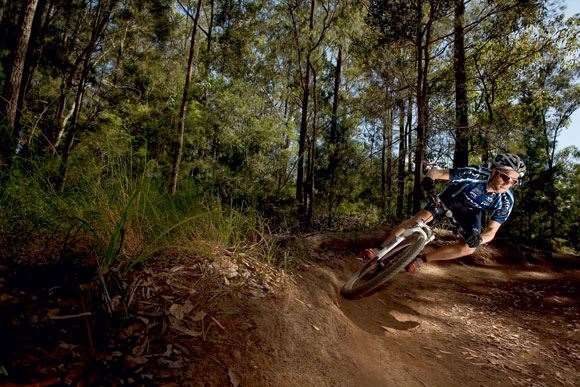 "My mileage normally falls somewhere between 500-700km a week.
"My mileage normally falls somewhere between 500-700km a week.Images: Krystle Wright
English’s wife is forever telling him he has an exercise addiction. He agrees wholeheartedly. The Port Macquarie (NSW) school teacher loves pedalling – the longer, the better. Twenty-four-hour mountain bike races – where competitors punch out as many laps of a set course as they can – are his idea of nirvana. “I love my job!” he says. “I just ride around, talking to people, eating food ... It’s great.”Don’t be fooled by the blase tone, however. When he won his second 24-hour world title at Canberra’s Mount Stromlo in October last year, he clocked 24 laps of the 18km course (finishing a full lap in front of his main rival, Canada’s Cory Wallace). Do the maths and you’ll realise that’s over 430km of dirt-track pedalling; a full day and a full night of lapping a course notable for its rockiness, its dustiness, and a nasty climb at its back end.Here’s how he does it.
Clocking miles
“My mileage always depends on how busy I am at school, but it normally falls somewhere between 500-700km a week, around 15 to 18 hours on the bike. All that riding will be on-road. If you’re riding in the bush, a lot of the time you’re riding down hills or you’re braking into a tricky section of track, and your heart has a chance to recover. But on a road bike you can keep your heart rate elevated the whole time, and really maximise your time on the bike. If I’m coming up to an important race, however, like the 24-hour Worlds, I’ll ride my mountain bike on the road for a couple of weeks before, just to get used to different riding positions.
“I’m fairly time-poor, being a full-time PE teacher, so I want to make the best of the hours I do get to pedal. If I have to be at school at eight in the morning till three in the afternoon, then I’ll do a few hours in the morning and another hour or two in the evening – that’s the only way I can get the three to four hours on the bike I need. It’s a big commitment – even when I’m not riding I’ll be negotiating sponsorships or planning my racing calendar, playing around like that.”
BPM
“In training my heart rate varies a lot. For example on Friday I normally do a fast, intense ride, where my heart rate will sit around 180 for a 45-minute session. Tuesday, on the other hand, is normally a gentle day; on that ride my heart rate will be down around 120.“On Monday and Thursday, where I start school an hour later, I’ll be on the bike at 5am and I’ll ride out to a 20-minute hill climb near my house and do three or four laps of that climb. On that ride my heart rate will really depend on how hard I want to go. This morning, for example, I was still pretty busted from a race, so my heart rate didn’t get much above 160. On other days it’ll be pushing 180. Personally, I believe it’s not necessarily how hard you climb the hills, it just about climbing the hills. I like looking at the total ascension of a ride and thinking, ‘That’s awesome – I’ve just got in, you know, 2000 vertical metres of climbing and that’s the same amount of climbing I’ll do in an average 100km-mountain bike race.’”
Why taper?
“Because I’m racing so often I try not to focus on one particular race. Take last year’s 24-hour Worlds for example: I had a race two weekends before and as soon as I finished the Worlds I was thinking about another race I had in two weeks’ time. So because of this constant workload, I really don’t go through too many phases with my training."
“But I certainly did a fairly serious ‘build’ leading into last year’s 24-hour Worlds. Two weeks out from the race I did a 44-hour week on the bike – which was just stupid! But it was leading into school holidays and I had the chance to ride seven hours a day – so I did it. The week after I didn’t have to do too much at all, so that was my taper week. I was just sort of riding around, getting used to the track ‒ I was still riding three to four hours a day but I backed the intensity right off."
“I find I go insane if I’m not riding enough. My legs start itching and I can’t sleep. Seriously – I have to make sure I don’t taper too much. I’ve worked out that I need to keep riding – I can’t take two days off in a row.”
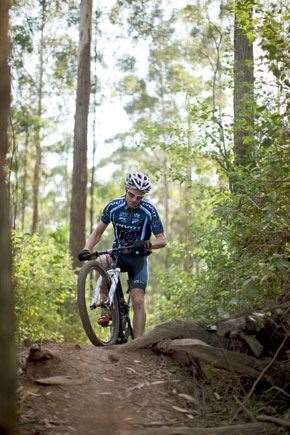 Mountain Biking Jason English
Mountain Biking Jason EnglishImages: Krystle Wright
Eating to ride
“I just love eating – food’s my biggest motivation for training and racing! Given the training I do a lot of people assume I’d struggle to keep weight on, but I actually have the opposite problem – I have to be very careful with what I eat to make sure I don’t put weight on. My wife’s a sport’s dietician so she has that area dialled in. She monitors my carbs very carefully, she cuts all the fat off the meat, she’s always asking me: ‘Do you really need the extra helping? Are you actually hungry now or are you just eating because you love food?’ And she’s right – I eat because I love it!Typically I’ll wake up before five in the morning and have a bowl of Weet-Bix and muesli. I’ll try and eat every hour or so while I’m training. This morning, for example, I did a hard four-hour ride, so I made two jam sandwiches and took them and a couple of sports bars on the ride with me. When I get back from the ride I’ll normally have another big bowl
of cereal. Lunch is typically a can of baked beans on toast, and dinner’s always something lean. Obviously I’m always snacking through the day on lollies and fruit. My wife’s always on to me about not consuming empty calories – so soft drinks and alcohol are not part of the diet!”
Riding to eat
“With my race food I like to work on the equation of one gram of carbohydrates per kilogram of bodyweight per hour of racing. So in a 100km-race – which will typically last just over four hours – I’ll try to eat around nine or ten packets of sports gel. You’re talking a serious amount of gel there! But you’re also talking high-intensity work on the bike, so I need to smash down a lot of calories."
“In a 24-hour race, again I’ll be looking to have around 70 grams of carbs an hour. I also try to eat meals that are similar to what I’d be eating on a normal day. So after six hours on the bike I might try and have a slice of pizza each lap for a few laps (laps typically take around 45 minutes). Some people can’t tolerate real food like that on the bike, but I crave it! I see it as reward time – you’re doing 24 hours on the bike, here you go – smack some pizza down! No guilt there ... Come breakfast time I’ll have a milkshake with Weet-Bix for three
or four laps. My body’s used to having cereal before and after riding so it works well. Of course, all this food I’m having on the fly – I can’t stop to eat, so my wife just passes it to me as I pedal through the transition area."
“Drinks wise, I’ll have water one lap and electrolyte drinks the next, rotating throughout the race. Looking at a 24-hour race, I could be drinking 20 litres of fluid,
so it’s important to keep the electrolytes up, keep getting the salt in.”
Battle tactics
“Strategy is a very big part of 24-hour races. I like to ride to my heart rate, so I’ll always race with a monitor on, and I’ll say, ‘Right, I don’t want to go over 165 beats per minute.’ Keeping under that mark means I’m burning fats as a fuel rather than the high-intensity work that burns carbohydrates and glycogen. At the Worlds I saw Cory Wallace, a Canadian, charge off at the start while I just wound back and rode to heart rate. You know, Cory is clearly fitter than me, but at the end of the day his legs were busted from going out too hard.
“I’m also constantly trying to make sure I ride as efficiently as possible. It’s amazing how many people will pedal right up to a corner on the track, then slam their brakes on and have to accelerate out of the corner. If I see a corner coming I always back off, roll into the corner, roll out of the corner, then pedal off. I haven’t had to use the brakes, haven’t put in that extra effort. It’s all about efficiency."
“Of course there’s often a trade-off with efficiency. It might, say, be worth pushing harder up a hill so I can sit behind people on the flats and the downhills. At the Worlds last year there was also a fair bit of technical, single-track downhill, so it was always worth putting in extra leading up to one of these sections to make sure I didn’t get stuck behind a rider who was a little bit slower on the downhill.”
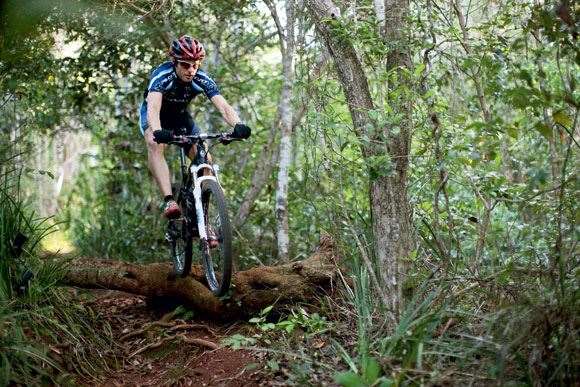 Mountain Scenic Biking Jason English
Mountain Scenic Biking Jason EnglishImages: Krystle Wright
The arsenal
“It’s also important to have lighting and equipment strategies in a 24-hour race. At the Worlds I had three bikes. So when I came into the transition area and the officials announced we needed to get lights on, I just dropped my bike on the ground, walked to the next one that had my lights set up on it, changed helmets to the one that had a light attached,changed to clear lens sunglasses and I was on the road. It probably took less than five seconds – unbelievably efficient. Other people who only had one bike, however, had to stop, attach the lights, find their batteries ... It’s a big advantage having two bikes that are exactly the same, both set up, ready to go. Then I had my third bike, which became a donor bike. Whatever I needed during the race I just ripped it off that bike – a wheel, the forks, the drive train. Of course, it ended up in pieces.
“There’s also a lot of strategy with tyres. These days everyone’s running tubeless tyres, but there’s still that trade-off: do you run a light-weight tyre that might make your bike half a
kilo lighter but risk a puncture, or do you take a heavier tyre and not run that risk? You know, half a kilo is a big advantage in a long race, but get a puncture and there’s six or seven minutes down the drain. It’s all about finding the right balance for different terrain. If I’m, say, racing at Port Macquarie, I can run the lightest, 400g tyres knowing I’m not going to get a flat because it’s not a rough course. But at Stromlo it’s fairly rocky so I ran 600g tyres.”
All in the head
“For the first six hours of a 24-hour race you’re genuinely racing – there are people everywhere and you’re trying to work out who’s a threat, who’s pushing hard. That makes it interesting. But when night time comes that’s when it gets mentally tough and that’s when I start setting little goals. Food works for me big time. I need to have little goals during long races, so as I’m pedalling I might be thinking, ‘Awesome! Dinner’s in three hours – pizza!’
“The worst time is around three o’clock in the morning – that’s when it starts getting hard to find a goal. Sometimes I see a slight tinge on the horizon and I’ll think, ‘Great, the sun’s coming up!’ Then four hours later I’m still pedalling and the tinge on the horizon looks exactly the same. It’s around that time that all I’m thinking about is breakfast. I just love breakfast – and those are the breakfasts I value the most.”
Collateral damage
“I think mountain-biking is a lot safer than road racing. On the road you might be doing 60km/h at the point of impact. In mountain-biking you’re more likely to be doing 20 or 30km/h, so by the time you’ve skidded and bounced along the grass, crashes normally aren’t a big deal."
“I’ve been quite lucky with crashes, but I did have a bad one two years ago – 12 weeks out from the 24-hour Worlds. It was in a 100km-race in Melbourne and I was coming fourth at the time. I knew it wasn’t an important race ‒ I was just treating it as a training ride ‒ so I was thinking I was doing pretty well. And then, with about 20km to go, I started feeling really good, and I thought, ‘Maybe I’ll have a crack here.’ And that’s the last thing I remember! Apparently I hit a tree and my head got pushed so far to the right that the tendons tore off the vertebrae and pulled some fragments of bone with them. The guy who was first on the scene told me when the ambulance guys gave me the happy whistle [morphine] I spat it out and was saying, ‘No, no, I’m fine!’
“About four weeks after that crash I crawled back on the wind trainer. I spent two weeks on that, with my back propped up, and then I was back on the bike, exactly five weeks out from the Worlds. At first I found it hard to pedal ‘circular’ because I’d spent the past few weeks on the trainer, but I somehow got fit enough in those five weeks to take out second at the Worlds. So that was pretty cool ... ”
– Aaron Scott
Related Articles

Renault blunder costs Ricciardo 'a great result'
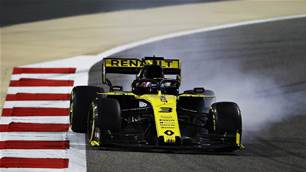
Ricciardo's F1 season start is 'unacceptable', says Renault boss





